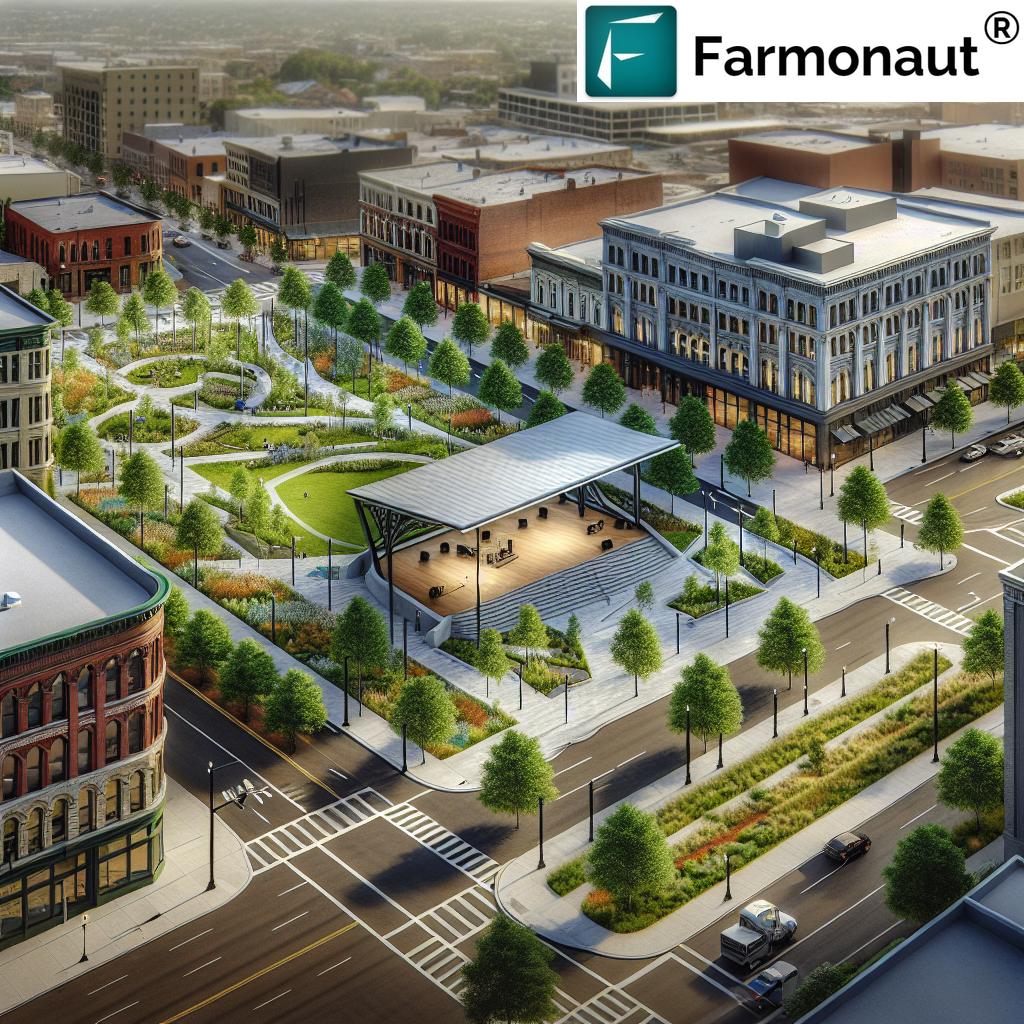Utah’s Growth Dilemma: Balancing Tourism Development and Affordable Housing in Ivins
“Ivins, Utah has transformed from a small farming suburb to a resort destination, experiencing over 300% population growth since 2000.”
In the heart of southern Utah, nestled among the striking red rock mountains, lies the city of Ivins. Once a quiet farming community, Ivins has undergone a remarkable transformation in recent years, becoming a focal point for Utah city growth and the complex challenges that come with rapid development. As we delve into this intriguing case study, we’ll explore how the short-term rentals impact and the surge in tourism have reshaped this small city, creating a delicate balance between economic prosperity and community preservation.

The Rise of Ivins: From Farming Suburb to Resort Haven
Ivins’ journey from a modest agricultural community to a bustling tourist destination is a testament to the power of strategic development and the allure of Utah’s natural beauty. Over the past two decades, this Washington County city has experienced explosive growth, transforming its landscape and economy in ways that few could have predicted.
The catalyst for this change came approximately 20 years ago when city officials made a pivotal decision to rezone the outskirts of Ivins for touristic development. This move was aimed at creating a robust commercial tax base to generate city revenue, reducing the reliance on residential property taxes. Little did they know that this decision would set in motion a series of events that would forever alter the fabric of their community.
The Resort Revolution
Today, Ivins is home to some of Utah’s largest and most prestigious resorts. Black Desert, Red Mountain, and The Retreat stand as towering testaments to the city’s transformation. These world-class establishments have not only put Ivins on the map for tourists but have also significantly boosted the local economy.
However, with great change comes great challenges. The influx of tourists and the rise of short-term rentals have created a complex web of issues that the city now grapples with daily. From affordable housing concerns to community opposition to development, Ivins finds itself at a crossroads, trying to balance the benefits of tourism with the needs of its long-term residents.
The Double-Edged Sword of Property Values
One of the most significant impacts of Ivins’ growth has been the dramatic shift in property values. As Mayor Chris Hart pointed out, “We’ve gone from being probably the lowest property value on average for a community in southern Utah 40 or 50 years ago to being now the highest.” This meteoric rise in real estate prices has been a boon for some property owners but has created significant challenges for others.
The average cost of a home in Ivins now surpasses that of neighboring cities by hundreds of thousands of dollars. While this increase in property values has undoubtedly benefited some long-time residents and investors, it has also made affordable housing in southern Utah an increasingly elusive goal for many.
The Short-Term Rental Conundrum
At the heart of the affordable housing debate lies the issue of short-term rentals. Critics argue that the proliferation of vacation rentals has exacerbated the housing shortage, driving up prices and limiting supply for long-term residents. Mike Cook, a representative of Defenders of Greater Ivins, a community group opposing certain development projects, stated, “Everyone knows that short-term rentals do nothing to help affordable housing. It is our understanding that they do quite the opposite, taking up space and limiting supply, therefore driving up prices.”
“Short-term rentals now account for approximately 20% of Ivins’ housing stock, significantly impacting the local real estate market.”
This sentiment is echoed by many in the community who feel that the focus on tourism and short-term accommodations has come at the expense of those seeking to make Ivins their permanent home. The delicate balance between catering to tourists and providing for residents has become a central issue in the city’s ongoing development discussions.
The Retreat: A Case Study in Controversial Development
Perhaps no project better illustrates the tensions surrounding Ivins’ growth than The Retreat. This large-scale development, spearheaded by Rize Capital, has become a flashpoint for debates about zoning, land use, and the future direction of the city.
The project began when Utah’s School and Institutional Trust Lands Administration (SITLA) sold 113 acres of residential/agricultural land on the outskirts of Ivins to Rize Capital. The land was rezoned for mixed residential/commercial use, paving the way for a resort and rental complex that would significantly alter the landscape of the area.
Community Opposition and Legal Challenges
The announcement of The Retreat’s initial plans, which included 1,035 units of resort and short-term rental rooms in multiple-story buildings, sparked immediate backlash from the community. The Defenders of Greater Ivins, formed in response to this development, went so far as to file a lawsuit challenging the city council’s approval process.
While the lawsuit ultimately failed, it served as a catalyst for negotiations between SITLA, Rize Capital, and the community. Mayor Hart acknowledged the controversy, stating, “It was almost presented in a way that emphasized the state’s ability to do this without city consent. The resistance that the residents of the city put up led to SITLA working with the city, with groups of residents and so forth, to try to come up with a compromise design.”
A Revised Vision
In response to the community outcry, Rize Capital undertook a comprehensive redesign of The Retreat. The revised plan, which reduced the number of units to 603 (including 210 long-term rental houses and 393 resort units), also incorporated significant concessions to address community concerns. These included the retention of 20 acres of publicly accessible open space, preservation of 2.5 acres of lava rock formations, and various environmental and infrastructural commitments to the city.
Rize Capital emphasized the potential economic benefits of the project, citing an independent analysis projecting a $16.6 million net positive impact for Ivins over 25 years. Additionally, the development is forecasted to generate over $1.9 billion in job creation and local economic activity through visitor and resident spending.
The Community Response: A City Divided
Despite efforts to address community concerns, the rapid pace of development in Ivins has left many residents feeling uneasy about the city’s future. A December 2022 survey of Ivins residents revealed a significant divide in opinions regarding the city’s growth management:
- 46% disapproved of how the city had managed growth over the past five years
- 26% approved of the city’s growth management
- 27% expressed neutrality on the issue
Perhaps most tellingly, over 70% of residents surveyed disapproved of high-density housing projects like condominiums and apartments. This strong opposition to certain types of development underscores the challenges facing city officials as they attempt to balance growth with community preferences.
Political Repercussions
The controversy surrounding Ivins’ growth has had tangible political consequences. In the 2024 city council elections, candidates Sharon Gillespie and Sharon Barton, who campaigned on platforms advocating for slower, more controlled growth, were elected to office. Their success reflects a growing sentiment among residents that the pace of development needs to be carefully managed to preserve the character and quality of life in Ivins.
The Economic Impact of Resort Development
While the debate over Ivins’ growth continues, it’s undeniable that the resort developments have had a significant economic impact on the city. The influx of tourists has created new job opportunities, increased tax revenues, and put Ivins on the map as a premier destination in southern Utah.
| Aspect | Pre-Development | Post-Development |
|---|---|---|
| Average Property Value | Lowest in southern Utah | Highest in Washington County |
| Annual City Revenue | Primarily from residential taxes | Significant increase from commercial taxes |
| Population | Small farming community | Over 300% growth since 2000 |
| Short-Term Rentals | Minimal to none | Approximately 20% of housing stock |
| Long-Term Rental Availability | Adequate for local population | Limited due to short-term rental conversion |
| Zoning Changes | Primarily residential/agricultural | Significant areas rezoned for touristic/mixed-use |
Projects like Black Desert, which recently hosted a PGA Tour event, have demonstrated the potential for large-scale resorts to bring national attention and significant economic activity to the area. However, even these success stories are not without controversy. Recent reports of temporary bleachers obstructing residents’ views of lava rock formations for an upcoming LPGA event have reignited debates about the impact of tourism on local quality of life.
The Future of Short-Term Rentals
As Ivins grapples with its newfound status as a tourist hotspot, the issue of short-term rentals remains at the forefront of community discussions. City Councilman Mike Scott highlighted the dramatic increase in tourist accommodations, noting that in just a few years, Ivins has grown from 158 units of tourist housing to more than 1,700 units – a significant figure considering the city’s total of about 4,500 residential units.
Mayor Hart acknowledges that while many short-term rental projects have already been approved, there is a growing sense within the community that Ivins has reached its capacity. “The sense around our community is that, ‘Hey, folks, we got enough,’ and most of the zoning that we have available for that use has been bought up and is in some stage of planning or approval,” he stated.
Balancing Act: Economic Opportunities and Quality of Life
As we’ve explored the complex dynamics of Ivins’ growth, it’s clear that the city faces a delicate balancing act. On one hand, the economic opportunities brought by resort development and tourism have transformed Ivins from a sleepy suburb into a thriving destination. On the other, the rapid pace of change has strained local infrastructure, altered the community’s character, and raised concerns about long-term sustainability.
The challenge for Ivins’ leaders moving forward will be to find innovative solutions that can accommodate growth while preserving the qualities that make the city unique. This may involve:
- Implementing stricter regulations on short-term rentals to ensure a healthy balance with long-term housing
- Exploring creative affordable housing initiatives to maintain a diverse community
- Investing in infrastructure improvements to manage increased traffic and resource demands
- Developing comprehensive land use plans that protect natural areas and maintain open spaces
- Engaging in ongoing dialogue with residents to ensure community needs are being met
Lessons for Other Growing Communities
Ivins’ experience offers valuable lessons for other cities facing similar growth pressures. It underscores the importance of proactive planning, community engagement, and the need to carefully consider the long-term implications of development decisions. As cities across Utah and beyond grapple with issues of affordable housing, tourism impact, and community character, Ivins stands as both a cautionary tale and a potential model for navigating these complex challenges.
For communities looking to manage urban growth effectively, tools like those offered by Farmonaut’s carbon footprinting solution can provide valuable insights into the environmental impact of development. By leveraging satellite technology and AI-driven analytics, cities can make more informed decisions about land use and resource management, ensuring sustainable growth that benefits all residents.
Conclusion: A City at a Crossroads
Ivins, Utah, stands at a critical juncture in its history. The decisions made in the coming years will shape the city’s identity for generations to come. As the community grapples with the challenges and opportunities presented by its rapid growth, it’s clear that there are no easy solutions. However, by fostering open dialogue, embracing innovative approaches to development, and prioritizing the needs of both long-term residents and visitors, Ivins has the potential to emerge as a model for sustainable tourism development in the American West.
The story of Ivins is far from over. As the city continues to evolve, it will be fascinating to see how it navigates the complex interplay between economic development, community preservation, and environmental stewardship. One thing is certain: the lessons learned in this small Utah city will have implications far beyond its borders, offering valuable insights for growing communities across the nation and around the world.
FAQ Section
Q: How has Ivins’ population changed since it began developing as a tourist destination?
A: Ivins has experienced over 300% population growth since 2000, transforming from a small farming suburb to a bustling resort town.
Q: What percentage of Ivins’ housing stock is now dedicated to short-term rentals?
A: Approximately 20% of Ivins’ housing stock is now comprised of short-term rentals, significantly impacting the local real estate market.
Q: How have property values in Ivins changed due to development?
A: Ivins has gone from having the lowest average property values in southern Utah to now having the highest in Washington County, with homes costing hundreds of thousands more than in neighboring cities.
Q: What major resorts have been developed in Ivins?
A: Ivins is now home to several large resorts, including Black Desert, Red Mountain, and The Retreat.
Q: How has the community responded to rapid development?
A: Community response has been mixed, with a 2022 survey showing 46% disapproval of the city’s growth management, while others appreciate the economic benefits. This has led to the election of city council members advocating for slower growth.
Earn With Farmonaut: Join Farmonaut’s affiliate program and earn 20% recurring commission by sharing your promo code and helping farmers save 10%. Onboard 10 Elite farmers monthly to earn a minimum of $148,000 annually—start now and grow your income!
For those interested in exploring how technology can aid in sustainable development and land management, Farmonaut’s crop plantation and forest advisory services offer innovative solutions. These tools can help communities like Ivins make data-driven decisions about land use and environmental conservation.
As we conclude our exploration of Ivins’ growth dilemma, it’s clear that the challenges faced by this small Utah city are reflective of broader trends in urban development and tourism. The lessons learned here can inform strategies for sustainable growth in communities around the world, highlighting the importance of balancing economic opportunities with quality of life for residents.
For more information on how satellite technology and AI can assist in urban planning and land management, visit Farmonaut’s API or check out the API Developer Docs.


















